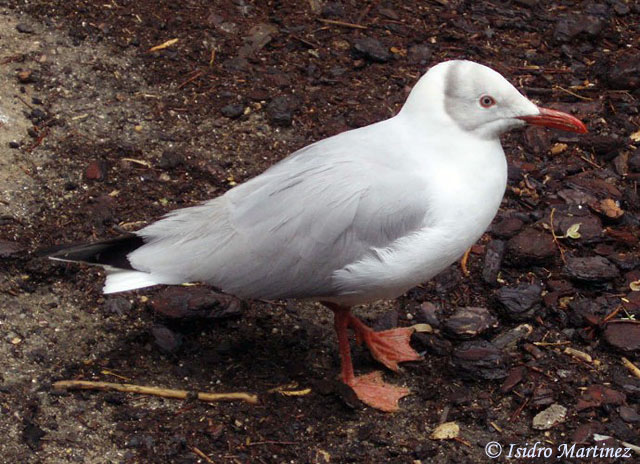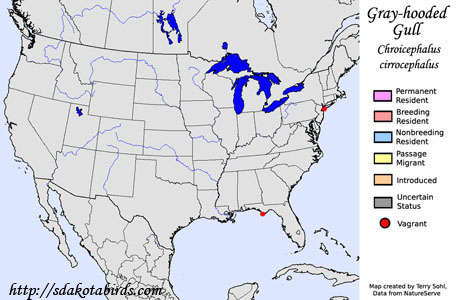| Length: 17 inches | Wingspan: 44 inches | Seasonality: Non-resident in South Dakota |
| ID Keys: The gray hood is present in breeding plumage, with darker streaks remaining in non-breeding plumage. Red bill and feet, gray wings, white underparts. | ||
 The
Gray-hooded Gull is a bird that is normally found in scattered parts of
Africa and South America. In North America, they were unknown, until a
sighting in Florida in 1998. In 2011, a bird found on Coney Island in
New York City caused quite a commotion, with birders flocking from around
the region to see the mega-rarity.
The
Gray-hooded Gull is a bird that is normally found in scattered parts of
Africa and South America. In North America, they were unknown, until a
sighting in Florida in 1998. In 2011, a bird found on Coney Island in
New York City caused quite a commotion, with birders flocking from around
the region to see the mega-rarity.
Habitat: Found around freshwater wetland habitats during the breeding season, as well as tropical and subtropical coastal areas. Found around a greater variety of aquatic habitats outside of the breeding season.
Diet: Omnivorous. Feeds heavily on fish when available, but will also feed on insects, mollusks, crustaceans, other invertebrates, eggs, fledgling birds, refuse, and carrion.
Behavior: Foraging technique depends on location and what food items are availble.
Nesting: In their native range, Gray-hooded Gulls are colonial nesters, with colonies in areas of wetland vegetation or on islands. The nest itself differs depending upon location. It may be just a simple scrape on the ground, or it may be a substantial structure built of grasses and wetland vegetation. The female lays 2 or 3 eggs.
Song: Loud around nesting colonies, with a crow-like "cawing" call.
Migration: Not truly migratory, as most birds stay relatively close to breeding locations. Some birds may disperse outside of breeding, however, but no regular or predictable migration is noted. African and South American populations evidently do not interact, but they are still considered the same species.
Interactive eBird map: Click here to access an interactive eBird map of Gray-hooded Gull sightings
Similar Species: Similar to the Brown-hooded Gull, a species not seen in North America. If seen well, the gray hood and other characteristics should be diagnostic in North America, should it occur again.
Conservation Status: Populations are stable, they are found over a wide geographic area, and they are common in parts of their range. The IUCN lists the Gray-hooded Gull as a species of "Least Concern".
Further Information: 1) The Gray-hooded Gull in North America: The First Documented Record
2) Cornell's Neotropical Birds - Gray-hooded Gull
3) New York Times - Rare Gull Lands at Coney Island
Photo Information: Photo taken by Isidro Martinez - Photo licensed under Creative Commons Attribution NonCommercial ShareAlike 2.0 Generic License.
| Click below for a higher-resolution map |
 |
| South Dakota Status: Non-resident in South Dakota |
Additional Gray-hooded Gull Photos (coming soon!!)
